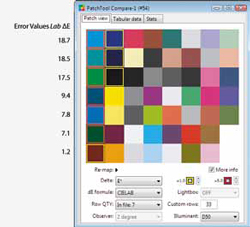articles/Computers/McNamee-goes-over-to-the-Dark-Side-page4
McNamee goes over to the Dark Side - part 4 of 1 2 3 4 5 6
by Mike McNamee Published 01/02/2014

Screen Performance
The screen performance has always been the criticised feature of Macs with shiny screens and, latterly, Retina screens. As well as reflecting the surroundings into the viewer's eye, the shiny screens confuse the spectrophotometers making screen calibration something of a challenge. Additionally the default luminance is always way too high. The iMac runs at around 290cd/m2, the Retina displays are even worse running to over 400cd/m2. The gamut of both iMac and Retina screens has been improved up to close to sRGB performance. This is some way below the gamut of true graphics monitors from the likes of Eizo and NEC which can achieve Adobe RGB, relevant to press work for which the cyans are more correctly displayed on screen.

Full Colour Analysis of Screen Performance
As we became more curious about the high errors in the monitor audit process, we found the analysis provided by i1 profiler to be lacking. We therefore harvested the data and ran it through Babel Color's Patch tool for a better look. As the screen grab shows, it is immediately apparent that the high errors lie in the cyans, blues and greens. Detailed analysis shows that the overwhelming bulk of the error lies in the chroma (saturation) component, the screen simply cannot deliver enough cyan to accommodate the tones from the cmyk printing process on which the target is based.
Looking at the gamut shape confirms this reasoning. The Adobe RGB gamut is normally required for pre-press proofing monitors (such as the Eizo ColorEdge and NEC Reference grade units); the gamut of the iMac is shown in dots and is well inside the required area.
Please Note:
There is more than one page for this Article.
You are currently on page 4
- McNamee goes over to the Dark Side page 1
- McNamee goes over to the Dark Side page 2
- McNamee goes over to the Dark Side page 3
- McNamee goes over to the Dark Side page 4
- McNamee goes over to the Dark Side page 5
- McNamee goes over to the Dark Side page 6
1st Published 01/02/2014
last update 09/12/2022 14:56:35
More Computers Articles
There are 18 days to get ready for The Society of Photographers Convention and Trade Show at The Novotel London West, Hammersmith ...
which starts on Wednesday 14th January 2026





